Purpose
Considerable enthusiasm exists for the concept of having living roots in the soil at all times, but very little data is available to show yield impacts either long or short term. Unfortunately, while the enthusiasm for this idea is real, there has been a regression towards more tillage in Ontario, especially in certain areas, over last 5 years. While there is no survey data on this shift, virtually every agronomist agrees that it is extremely significant & disheartening from both a soil erosion & soil health standpoint. This means that coordinated trials for comparative data under Ontario conditions are essential. The Thames Valley/Heartland Tier 2 project of 2015-2018 showed significant negative impacts on yield in both corn and soybeans in the “plant green” plots compared to other treatments. These yield losses appeared to be associated with poor slot closure, as well as more inconsistent seed to soil and soil to plant contact. After 3 years of the project, no increase in soil health could be measured. This project continues the Thames Valley/Heartland Tier 2 “Roots Not Iron” project, with adjustments to the “plant green” treatment that will hopefully overcome the challenges noted above in the original project. The majority of the sites will continue on from the original project, which should also give an extended period of time for soil health improvements to develop and be measured.
Methods
Three replicate field scale plots were established to continue to assess the Roots Not Iron concept. The treatments continued at previously established sites. Minor adjustments were made to the original protocol. The seeding rate of the multi-species cover crop planted after wheat were reduced from 110lbs/acre to 50lbs/acre, and spring strip-till was performed before corn planting to hopefully address slot closure and seed-soil contact issues. Cereal rye planted after corn harvest replaced annual ryegrass interseeded at V6. Full details of each treatment are listed below.
- Cooperators current conventional best management practices with no cover crop. Tillage following co-operators normal practice.
- Standard best management of cover crops including clover in wheat (reseed with oat/pea mix if poor establishment), burn down in fall. Tillage following co-operators normal practice.
- #RootsNotIron (green all the time) A multi-species (minimum 8 species) cover crop containing a mixture of oats, radish, clover, cereal rye, sunflower, peas, phacelia, sun hemp will be planted after wheat harvest and left to over winter. The cover crop will be terminated in the spring and strip tilled prior to corn planting. Cereal rye will be planted following corn harvest and will be terminated in the spring, prior to no-till soybeans being planted
Baseline soil health assessments (Solvita test for biological activity) and ON-CSHA
(Cornell Soil Health Assessment) were taken at the end of the Roots Not Iron 1.0 project and will be taken again at the end of the Roots Not Iron 2.0 project to measure longer term (6 year) soil impacts, with potential to measure phosphorous movement, nitrogen cycling etc.
Applications of manure if desired by individual cooperators to be at same levels across all treatments and repetitions, with manure nutrient values taken into consideration.
Results
The yield results from the 3 locations in 2018 that were in wheat are shown in Table 1. There was essentially no yield difference between treatments at any of the 3 locations.
Table 1: Wheat Yield Results (bu/acre)
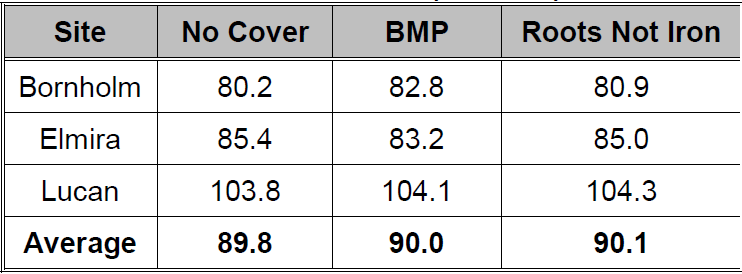
Cover crop biomass measurements were taken in early November. These measurements do not account for root growth but give an indication of how much above ground biomass was been created. A 70% oats, 30% peas mixture was planted in the BMP treatment at the Lucan locations in both 2017 and 2018 due to poor clover establishment. The fall cover crop growth at the Bornholm location is shown in Image 1. The picture on the left was taken on October 15th, while the picture on the right was taken November 8th a couple weeks after the clover was desiccated.
Table 2: Fall Cover Crop Biomass After Wheat
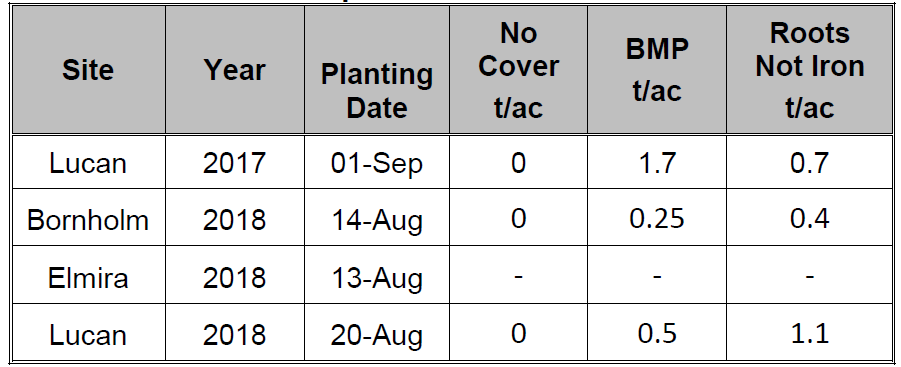
Image 1: Multi-Species Mix and Single Cut Clover (BMP) at Bornholm
 The 2018 corn results are shown in Tables 3, 4, and 5. The spring cereal rye growth was variable with some winter kill occurring in lower areas of the field but overall winter survival was good. Image 2 shows the amount of cereal rye growth at the Lucan location when the corn began to emerge. Greenness ratings were taken on the same day as the picture (Image 2) was taken and are shown in table 3. Greenness ratings were conducted using the Canopeo app, developed by the Soil Physics Research Group at Oklahoma State University. It gives an indication as to how much of the ground is covered by green plant material.
The 2018 corn results are shown in Tables 3, 4, and 5. The spring cereal rye growth was variable with some winter kill occurring in lower areas of the field but overall winter survival was good. Image 2 shows the amount of cereal rye growth at the Lucan location when the corn began to emerge. Greenness ratings were taken on the same day as the picture (Image 2) was taken and are shown in table 3. Greenness ratings were conducted using the Canopeo app, developed by the Soil Physics Research Group at Oklahoma State University. It gives an indication as to how much of the ground is covered by green plant material.
Table 3: Greenness Rating

Image 2: Cover Crop Growth at Lucan
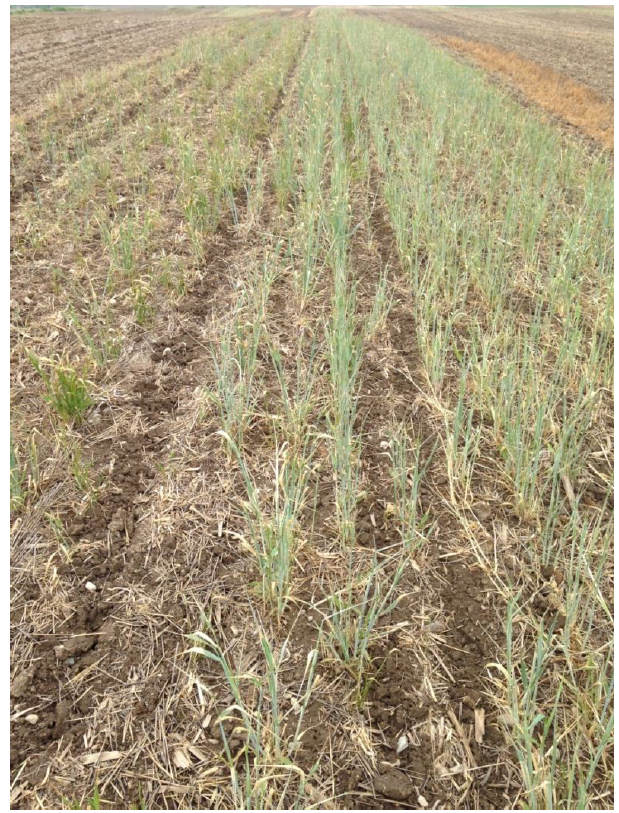
Plants were tracked through the growing season to determine the impact that the 3 treatments have on plant emergence, rate of growth, and plant height. Table 4 shows the number of plants that emerged each day based on 5.3 meter length of row (1/1000 acre). The roots not iron treatment had the most plants emerged on day 1 which could indicate that even with strip-till the planter still did not get the seed planted as deep in the roots not iron plot as the other 2 treatments. Overall the roots not iron treatment had a 5% reduction in plant population (33,500 vs 35,400).
Leaf tips were counted on June 15. The results from the No Cover and BMP treatments are very similar for plants that emerged on the same day. However, the plants in the roots not iron treatment are almost an entire leaf behind. This is consistent with the outcome found in the initial project.
Plant heights were variable based on day of emergence. Overall the BMP treatment was the tallest while there was little difference in height between the No Cover and Roots not Iron treatments.
Table 4: In Season Corn Measurements
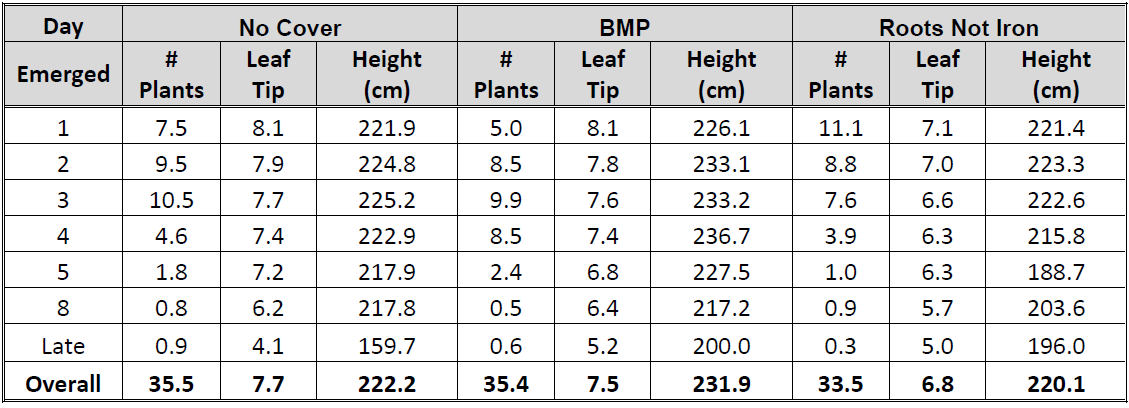
Corn yield results are shown in Table 5. On average the roots not iron treatment still had the lowest yield numerically, but it is a drastic improvement compared to the results from previous trials. In the roots not iron 1.0 project the roots not iron treatment yielded 16.6 bu/acre less than the no cover treatment. The improved results from the roots not iron treatment could potentially be due to poor and variable rye establishment in the treatment or possibly due to the introduction of strip-till. More research will need to be conducted before any potential conclusions can be made.
Table 5: Corn Yield Results (bu/acre)

The soybean yield results are shown in Table 6. The results from the Dungannon location should be viewed separately from the Lucan location as there was no annual ryegrass cover crop seeded in the roots not iron treatment. Due to a severe rain event that occurred on June 22nd 2017 at Dungannon we were not able to inter-seed annual ryegrass into the corn crop. Overall soybean yields were outstanding at both locations. The results from the Lucan location are similar to the results in the first stage of this project, which showed a yield loss of 2.2 bu/acre with the roots not iron treatment. Interestingly the yields increased at the Dungannon site, which did not have any annual ryegrass cover crop in the root not iron treatment. Annual ryegrass has had a negative impact on stand establishment over the course of this project. The stand count results are shown in Table 7.
Table 6: Soybean Yields
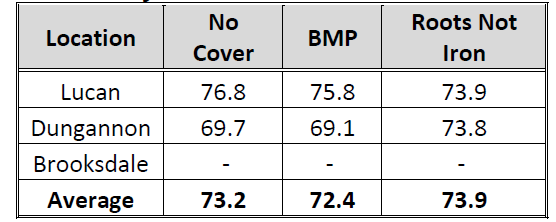
The soybean population was reduced by 7% at the Lucan site in the roots not iron treatment. This is consistent with results from the first stage of this project which showed a 10% stand reduction in the roots not iron treatment. While this did not reduce yields by 10%, it does indicate the problems associated with living roots holding tightly to soil, and the difficulties that this can present when attempting to get good seed to soil contact and close the slot.
Table 7: Soybean Stand Counts
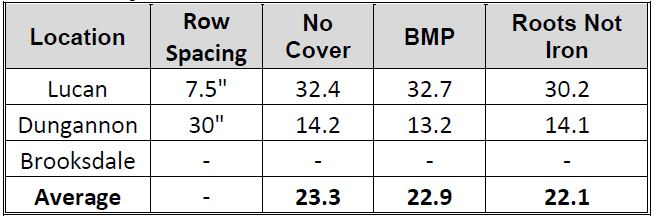
Summary
There was little difference in wheat yields across treatments. These findings are similar to what was seen in the first stage of this project.
There was a 4 bu/acre reduction (numerical, not statistical) in corn yields with the plant green treatment which is a drastic improvement from the results seen in the first stage of this project where yields were reduced by 16.6 bu/ace. It was hypothesized that emerging corn plants sensing the presence of other green plants nearby caused the corn plant to alter its growth pattern, along with difficulty in getting sufficient seed/soil contact through masses of living roots. More research will need to be conducted to determine if the addition of strip-till caused the improvement in yields in the plant green treatment or if it was due to poor cover crop establishment.
From yield numbers in this project, it appears soybeans may be able to handle the stress of plant green better than corn. Soybeans suffered only minor yield loss when planted into a green cover crop. Beginning in 2019 soybeans will be seeded into cereal rye instead of annual ryegrass to see if there is any improvement in yield. Due to a late corn harvest the cereal rye was not broadcast until November 30th but has germinated as shown in image 3 which was taken on January 8th.
Image 3: Cereal Rye Establishment on January 8th
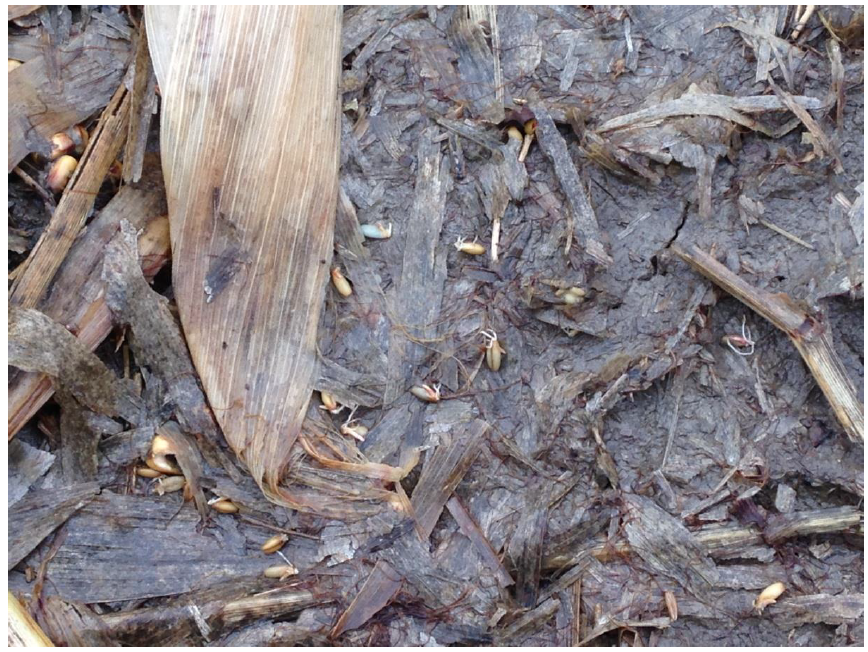
Next Steps
This project will be continued for another 2 years. Beginning in 2019 soybeans will be seeded into cereal rye instead of annual ryegrass to see if there is any improvement in yield.
Acknowledgements
Huge thanks to our co-operators. Thanks to administrator Marian Desjardine. Special thanks to Cathy Dibble for helping to coordinate sites and data. This project would not be possible without the support and funding of the Ontario Soil and Crop Improvement Association.
Project Contacts:
Peter Johnson, Agronomist, Real Agriculture, pjohnson@realagriculture.com
Shane McClure, Research Lead, shane_mcclure@hotmail.com
Cathy Dibble, Thames Valley SCIA cathy.dibble@ontariosoilcrop.org
Location of Project Final Report:
Peter Johnson, Agronomist, Real Agriculture, pjohnson@realagriculture.com
